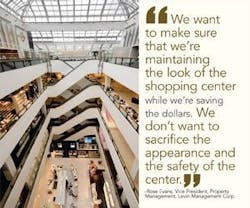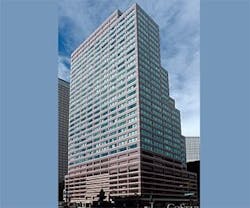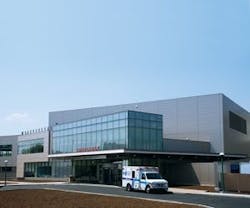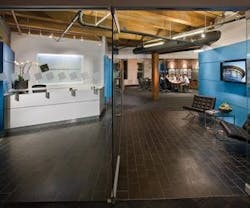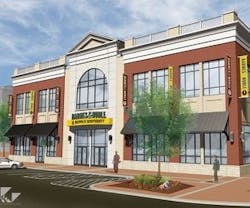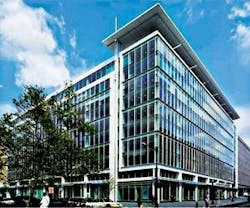Newsworthy
Reducing Operating Costs is Key to Shopping Center Management Success
Robert Carson, executive vice president, and Rose Evans, vice president, property management, at Levin Management Corp. in North Plainfield, NJ, discuss how they’re controlling costs for Levin’s shopping centers – and how you can control your operating costs.
Buildings: Why is reducing operating costs so important for retail facilities in this economy?
Carson: One reason is to stay profitable or at least in good shape through these tough economic times. The expenses that a landlord has to keep the shopping center looking good and well maintained gets passed through to tenants in the leases, and so we’re looking to reduce those costs for the tenants.
Buildings: What things can be done to immediately reduce operating costs on a day-to-day basis without reducing services or aesthetics in the facility?
Evans: We will rebid our services and offer a longer-term contract to contractors for a reduction in the actual expense for services. We will look at shopping centers with vacancies and reduce services that are applicable – you don’t have to pick up trash at vacancies, so you would reduce those expenses. We also look at things like utility bills, real estate taxes, and sewer bills to monitor for problems that we could fix and, thus, reduce our costs. So, a lot of it is paying attention to details and being aware of where you can achieve the savings. We want to make sure that we’re maintaining the look of the shopping center while we’re saving the dollars. We don’t want to sacrifice the appearance and the safety of the center.
Buildings: What are your long-term savings strategies? How can your cost-saving efforts help your building’s tenants?
Carson: We’re implementing much more efficient types of lighting that can be used to save not only energy, but also on maintenance costs. We’re also reusing the infrastructure of existing centers. So if we’re doing something new at the center, we’re trying to reuse the existing buildings as much as possible. We’re also using some things in the renovation that will save money in the long run, such as energy-efficient HVAC units, and more energy-efficient glass, storefronts, and roofing insulation.
We’re also looking to use preventive maintenance as a way to extend the life of things such as roofing and parking lots.
Evans: These cost-saving benefits transfer to the tenants in their common area maintenance (CAM) payments. They pay their common area maintenance charges all year, and, at the end of the year, we do a reconciliation so they can see the savings that we achieved for the year, and they will see potentially reduced CAM payments.
Buildings: What advice do you have for shopping center managers trying to reduce costs?
Evans: One of the things that I would talk about is the property managers themselves. They spend a lot of time at the centers, and we provide training for them. We have monthly meetings where they’re sharing what’s going on at their property, what projects they’re working on, and how something that they’ve done at their own center to achieve savings might be done at several other centers to achieve similar savings.
Likewise, we have vendors come in to do teaching programs for the property managers each month: For instance, how do you do a good roof inspection and what do you look for? Additionally, we have the property managers meet with tenants, and watch to see how tenants are doing.
New Massachusetts Code Makes Buildings More Energy Efficient
The Massachusetts Board of Building Regulations and Standards has adopted a new stretch energy code for small and mid-sized commercial buildings that would make new commercial buildings under 100,000 square feet up to 30 percent more energy efficient than base standards and reduce carbon emissions by almost 40 percent.
The stretch code applies to new and existing building types, and is based on the New Building Institute’s (NBI) protocol, Core Performance. The NBI, a nonprofit organization that aims to improve the energy performance of commercial buildings, developed Core Performance as a direct path to high-performance building that doesn’t require remodeling. The NBI has been working alongside Northeast Energy Efficiency Partnerships to bring this new stretch code to the state.
The Core Performance basic requirements in the stretch code include standards for measures such as window performance, lighting controls, mechanical equipment efficiency, and demand-control ventilation. There are also 14 optional measures that local government entities could adopt, including heat recovery, night venting, and daylighting.
Municipalities in the state can choose to either adopt the new code, 780 CMR 120.AA, or a project team can provide documentation that the building’s energy requirements are at least 20 percent below the ASHRAE 90.1-2007 standard.
Office Temperature Study Examines Comfort-Cost Relationship
“Temperature Wars: Savings vs. Comfort” is the new study released by the Intl. Facility Management Association (IFMA) that takes an in-depth look at the most common thermal complaints made by workers and the variety of ways facility professionals respond to them. This 2009 study identifies when most thermal complaints occur, the nature of the complaints, and the actions taken.
The study found that 94 percent of respondents say the most common HVAC complaint is the temperature being too cold, and 91 percent say the most common complaint is the temperature being too hot. Building occupants adjust to thermal comfort issues in a variety of ways, including the use of personal fans or heaters, or by a change in clothing. The study found that 90 percent of facilities professionals will check the temperature in the area of the complaint, 87 percent validate that the HVAC system is working properly, and 75 percent adjust thermostats to provide greater comfort.
Denver Financial Center is First Denver BOMA 360 Performance Building
Transwestern’s Denver office an-nounced that the Denver Financial Center is the first building in Denver to be designated a BOMA 360 Performance Building. The 435,672-square-foot, Class-A building is located at 1175 Sherman Street and 1776 Lincoln Street in Denver’s Central Business District.
The BOMA 360 Performance Program was developed by BOMA Intl. to recognize and validate commercial properties that demonstrate best practices in all major areas of building operations and management.
The Denver Financial Center is owned by US Premier Office Equities LP, a joint venture of USAA Real Estate Co. and other institutional investors.
Economic Projections Off by Wide Margin on Potential Energy-Efficiency Savings and GHG Emissions Cuts
The American Council for an Energy-Efficient Economy (ACEEE) has developed a new diagnostic tool that builds on the available economic data and the larger historical record to evaluate the recent assessments of climate-change legislation now before Congress.
The ACEEE reports that, based on the available record and the economic evidence to date, energy efficiency is a substantially larger and more cost-effective resource than most economic policy models now acknowledge. According to ACEEE, studies that forecast economic harm if the United States moves to curb greenhouse-gas emissions are flawed because they do not take into account the actual U.S. track record on energy-efficient advances, and, thus, they significantly understate the potential benefits.
According to the ACEEE findings, energy efficiency can provide a large percentage of greenhouse-gas emissions reductions needed before 2050, achieve trillions of dollars of net energy bill savings for consumers and businesses, and usher a small benefit to the nation’s gross domestic product (GDP) and job market.
LAUSD Boasts Historic Number of LEED Accredited Professionals
The Los Angeles Unified School District (LAUSD) is a national leader among school districts working with the U.S. Green Building Council’s (USGBC) LEED APs to support green building. The district boasts 117 credentialed LEED APs in its school construction and modernization program.
LEED Professional Accreditation distinguishes building professionals with the knowledge and skills to successfully steward the LEED certification process. The growing number of LEED APs at LAUSD is part of its Facilities Services Division’s Training Development Program, which furthers professional development and focuses on the use of best practices throughout the industry. It’s also part of LAUSD’s Sustainability Initiatives Program, which is working to make all LAUSD schools greener through programs to reduce energy consumption, water consumption, and greenhouse-gas emissions by 10 percent by 2012. Additionally, the district intends to seek LEED certification for all of its new school construction projects through 2012.
Elizabeth A. Connelly Emergency Center Opens
The new Elizabeth A. Connelly Emergency and Trauma Center at Staten Island University Hospital is now open. Construction on the two-story trauma and emergency room building was completed on an accelerated schedule to fulfill the urgent community need and will triple the emergency room capacity.
The $39 million addition to the hospital’s original 1979 structure was built by Skanska USA Building Inc. and will house a 39,000-square-foot emergency and trauma center on the first floor, and a 24,900-square-foot educational center for residency programs for doctors and for community medical education, as well as a medical library, will be on the second floor.
The project also included improvements to the hospital’s existing facilities, the last of which are scheduled for completion this fall.
Margulies Perruzzi Architects Office Achieves LEED Silver Certification
Boston architectural firm Margulies Perruzzi Architects’ new office has been awarded LEED Silver certification from the U.S. Green Building Council (USGBC).
Its new office space is located in a historic building dating from 1888 that merges the old mill building’s brick-and-beam construction with a modern interior, featuring glass, stainless steel, and bold colors. Green design and construction features include diverting 80 percent of construction and demolition debris from landfills, the reuse of 70 percent of existing furniture and the selection of materials and furniture with recycled and recyclable content, adjustable lighting controls and energy-efficient indirect lighting, low-emitting materials to reduce the quantity of indoor air contaminants, and wood harvested in an environmentally responsible manner. Additionally, Margulies Perruzzi Architects purchased materials made within a 500-mile radius, which supports the regional economy and reduces the cost and environmental impact of transportation and delivery.
The 13,000-square-foot space utilizes a single-floor layout to allow for more collaboration and features a conference center, informal meeting areas, and a roof deck overlooking the Boston skyline.
Rowan Boulevard Project is Building a Downtown Community
Glassboro, NJ-based Rowan University’s new student housing at Rowan Boulevard isn’t just providing housing for 560 Rowan University students, but is “recreating a downtown that is a community,” says Greg Filipek, a principal at Sora Holdings LLC, the developer of the Rowan Boulevard project.
The two phases of new student housing are comprised of 28 one-bedroom efficiency units and 214 four-bedroom suites, with common areas featuring exercise and weight rooms, meeting rooms, laundry facilities, and a public safety satellite office. In addition, the Rowan Boulevard project also includes a 36,000-square-foot Barnes & Noble with a Starbucks Café, a Holiday Inn Express Hotel & Suites with an adjacent restaurant, and several mixed-use buildings, including 185,000 square feet of retail space, an additional 307,000 square feet of residential space, and 40,000 square feet of office space.
The Rowan Boulevard project is at the heart of the Glassboro, NJ, downtown revitalization project, which is forming a new 26-acre, 100-foot-wide corridor stretching one-third of a mile from the foot of the Rowan University Campus to the center of downtown. The project, which is due to be completed in 2012, is expected to attract a minimum of 60 new retail stores, generating a minimum of $48 million in annual sales.
USGBC Announces LEED Platinum Certification of New Headquarters Building
The U.S. Green Building Council (USGBC) announced that its new headquarters building, located in the Foggy Bottom district of northwest Washington, D.C., has been awarded LEED Platinum certification. It’s the first project to certify under the latest version of LEED.
The 75,000-square-foot, two-story office building features an open staircase; a bright lobby; a two-story-tall water feature; elevator lobby, reception, and conference breakout areas clad in 500-year-old gumwood salvaged from the Tennessee River; as well as a 40-percent reduction in water use and energy use to be less than half that of a typical office. The building also includes a dashboard system to provide real-time feedback on energy use, floor-to-ceiling glass windows to provide daylighting, and an electronic window shade system to maximize natural light and minimize glare. Additionally, all members of the design, engineering, and construction teams (from Envision Design, GHT Limited Consulting Engineers, and James G. Davis Construction Corp., respectively) are LEED Accredited Professionals.
More than 35,000 projects are currently participating in the LEED system, comprising over 5.6 billion square feet of construction space in all 50 states and 91 countries.
Property Tax Reduction Could Help Lower Operating Costs
The top goal for Grubb & Ellis | Commercial Florida, a leading commercial property broker, is to reduce property tax assessments in order to lower operating costs for building owners and managers.
According to Don Lombardi, director of tax assessment services and member of the Distressed Property Services Group at Grubb & Ellis | Commerical Florida, lowering taxes can greatly improve the operating profile of a building and increase its market value.
Lombardi’s specialty is reducing property taxes, which is one of the biggest expenses for commercial properties.
Jeff Sweeney, president at Grubb & Ellis | Commercial Florida, says that tax assessments should reflect the declining values of commercial property, and that the firm’s objective is to assist county property appraisers. The resulting cost savings to building owners has the possibility of staving off foreclosure.
